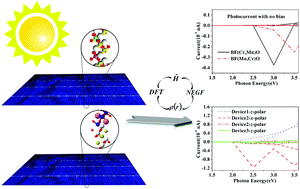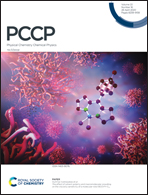Inorganic photovoltaic cells based on BiFeO3: spontaneous polarization, lattice matching, light polarization and their relationship with photovoltaic performance†
Abstract
Inorganic ferroelectric perovskite oxides are more stable than hybrid perovskites. However, their solar energy harvesting efficiency is not so good. Here, by constructing a series of BiFeO3-based devices (solar cells), we investigated three factors that influence the photovoltaic performance, namely, spontaneous polarization, terminated ion species in the interface between BiFeO3 and the electrode, and polarized light irradiation. This work was carried out under the framework of the density functional theory combined with the non-equilibrium Green's function theory under a built-in electric field or finite bias. The results showed that (1) the photocurrent is larger only under a suitable electronic band gap rather than larger spontaneous polarization; (2) the photocurrent reaches the largest value in the Bi3+ ion-terminated interface than in the case of Fe3+ or O2− with the SrTiO3 electrode; (3) the photocurrent can be largely enhanced if the polarized direction of the monochromatic light is perpendicular to the spontaneous polarization direction. These results would deepen the understanding of some experimental results of BiFeO3-based solar cells.



 Please wait while we load your content...
Please wait while we load your content...